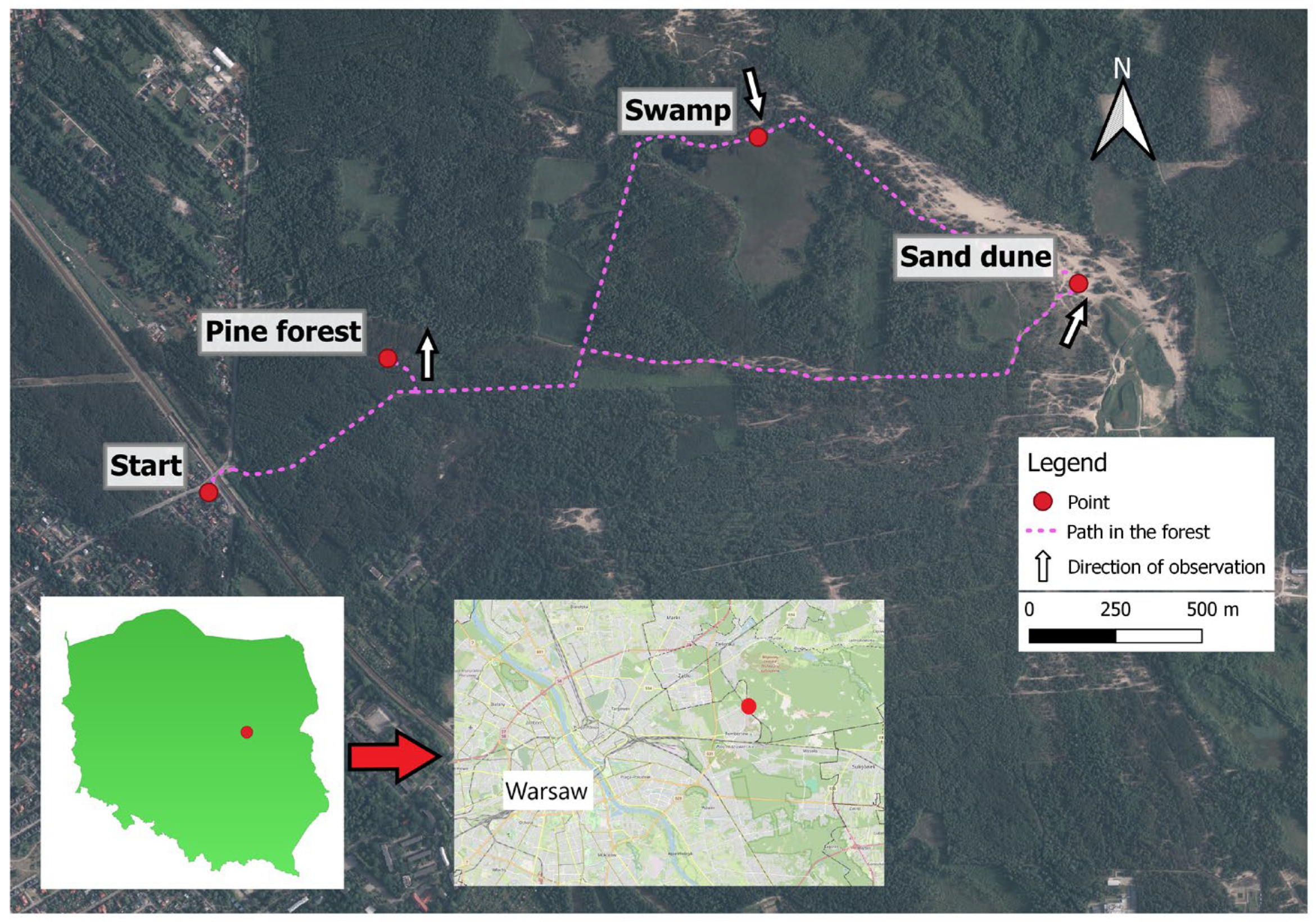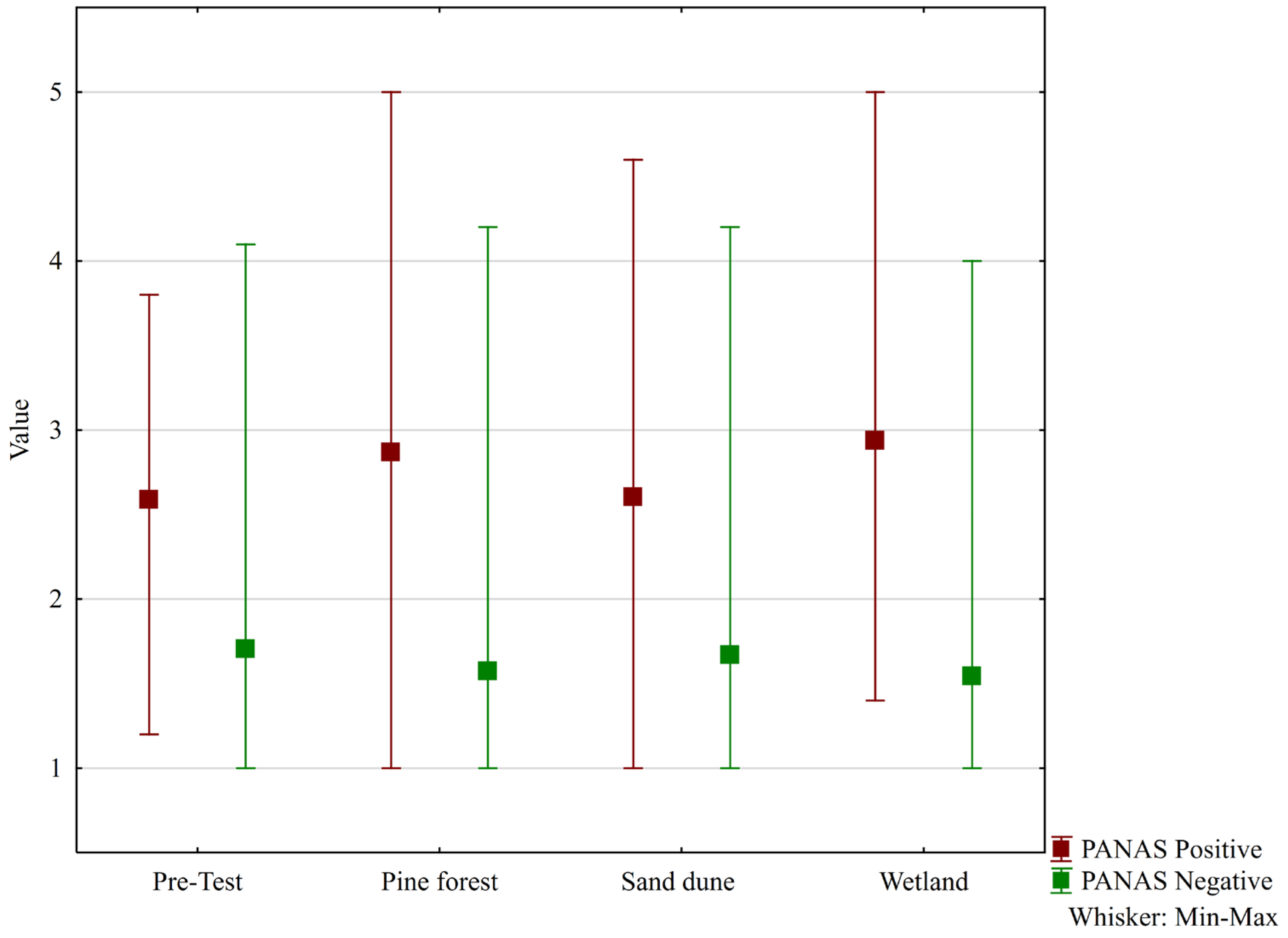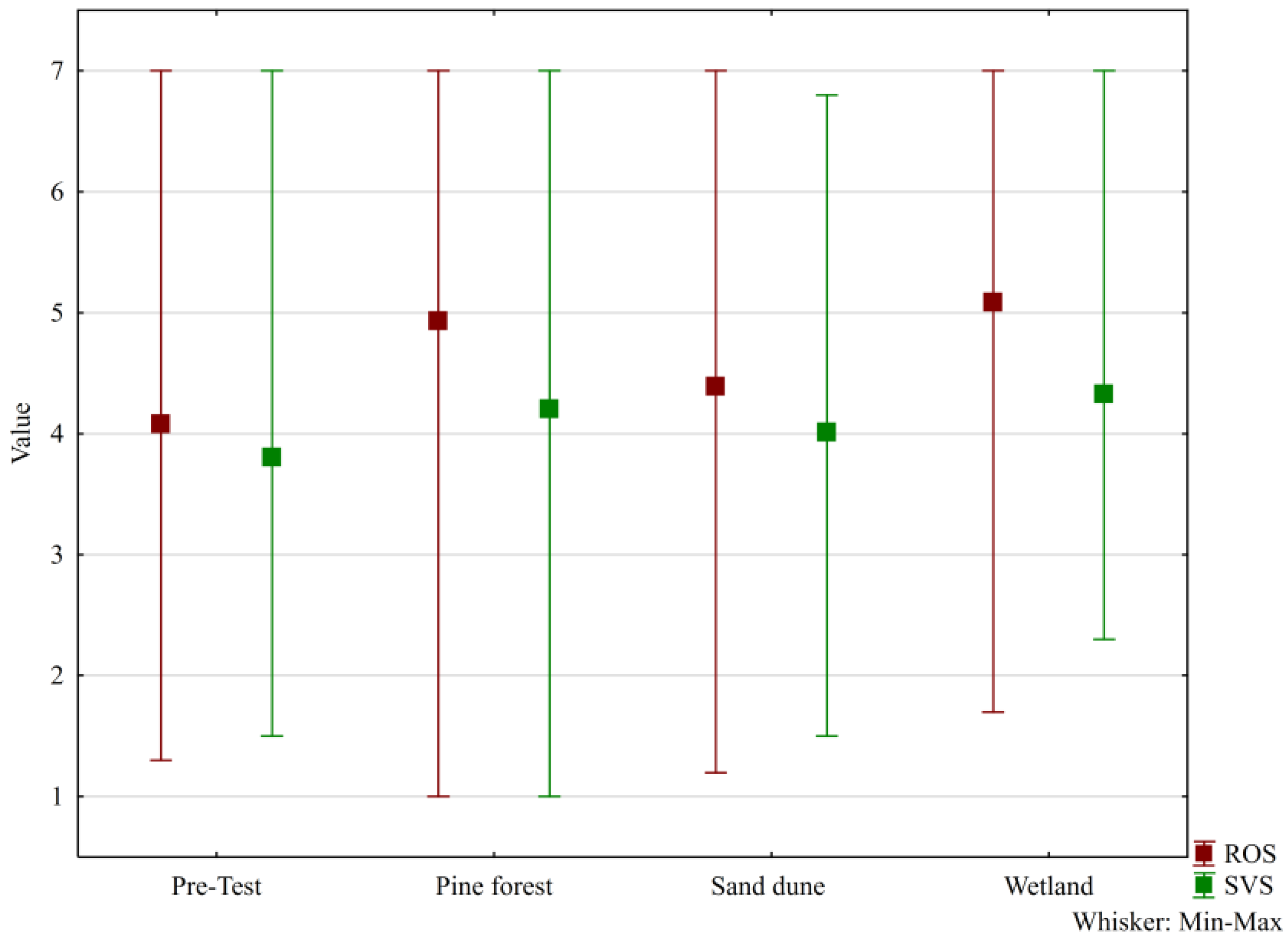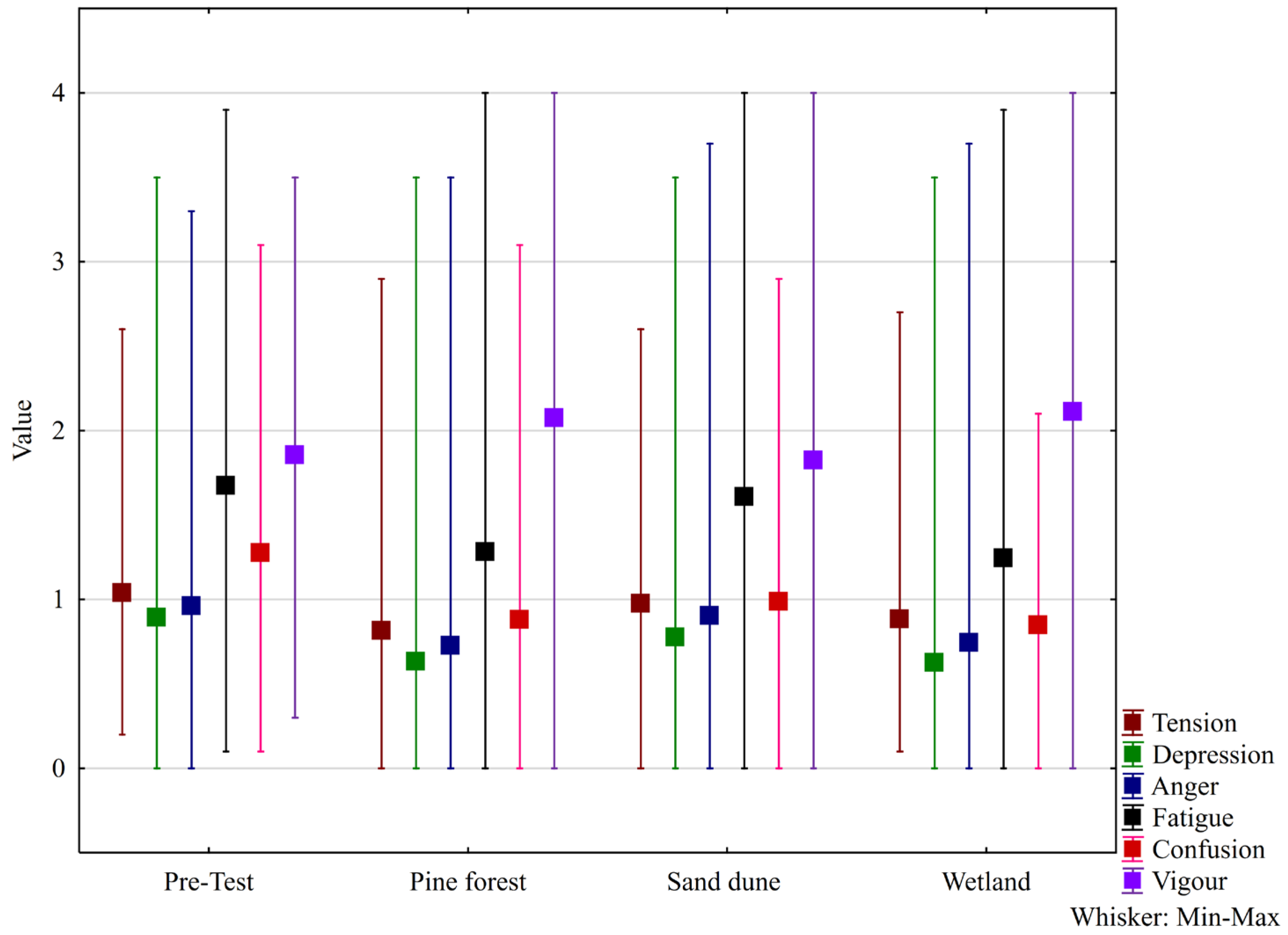The Impact of Open Forest Habitats on Psychological Well-Being
Abstract
1. Introduction
2. Literature Review
2.1. Green Spaces’ Importance for Mental Health
2.2. Forest Space Features and Mental Wellness
2.3. Open Habitats in the Forest and Their Regeneration Potential
3. Materials and Methods
3.1. Participants
3.2. Study Sites
3.3. Procedure
3.4. Measurements
- Subjective Vitality Scale (SVS)—the test contains four questions measuring vitality, and this scale is valid and reliable [61].
- Profile of Mood State (POMS), a test adapted to Polish conditions by Dudek and Koniark [62]. It is based on six subscales measuring levels of tension (T), Anger (A), Fatigue (F), Depression (D), Confusion (C), and Vigor (V). POMS is a reliable and contemporary measure of mood state, which was previously used by, for example, Furuyashiki et al. [63] and Yu et al. [64] to assess the impact of nature on mood.
3.5. Data Analysis
4. Results
4.1. Reliability of Scales
4.2. Positive and Negative Affect Schedule (PANAS)
4.3. Restorative Outcome Scale (ROS) and Subjective Vitality Scale (SVS)
4.4. Profile of Mood States (POMSs)
5. Discussion
6. Conclusions
Author Contributions
Funding
Institutional Review Board Statement
Informed Consent Statement
Data Availability Statement
Conflicts of Interest
References
- Transforming Our World: The 2030 Agenda for Sustainable Development. Available online: https://sdgs.un.org/2030agenda (accessed on 11 April 2025).
- Biodiversity Strategy for 2030. Available online: https://environment.ec.europa.eu/strategy/biodiversity-strategy-2030_en (accessed on 22 April 2025).
- World Health Organization. Regional Office for Europe. Urban Green Spaces and Health; World Health Organization. Regional Office for Europe: Copenhagen, Denmark, 2016; Available online: https://iris.who.int/handle/10665/345751 (accessed on 5 February 2025).
- Hartig, T.; Mitchell, R.; De Vries, S.; Frumkin, H. Nature and health. Annu. Rev. Public Health 2014, 35, 207–228. [Google Scholar] [CrossRef]
- World Health Organization. Global Burden of Mental Disorders and the Need for a Comprehensive, Coordinated Response from Health and Social Sectors at the Country Level; World Health Organization: Geneva, Switzerland, 2016; Volume 30, Available online: https://apps.who.int/gb/ebwha/pdf_files/EB130/B130_9-en.pdf (accessed on 5 February 2025).
- Lam, R.W. Depression (Oxford Psychiatry Library); Oxford University Press: Oxford, MS, USA, 2018. [Google Scholar]
- Pratt, L.A.; Brody, D.J. Depression in the United States Household Population, 2005–2006. NCHS Data Brief. 2008, 7, 1–8. [Google Scholar]
- World Health Organization. The World Health Report 2001: Mental Health: New Understanding, New Hope; World Health Organization: Geneva, Switzerland, 2001; Available online: https://books.google.pl/books?hl=pl&lr=&id=GQEdA-VFSIgC&oi=fnd&pg=PR9&ots=d3TzSHciwC&sig=C8r4N7d5ezEniTinIukclYVfIqs&redir_esc=y#v=onepage&q&f=false (accessed on 10 February 2025).
- Denche-Zamorano, A.; Rodríguez-Redondo, Y.; Rojo-Ramos, J.; Miguel-Barrado, V.; Sánchez-Leal, A.; Pérez-Calderon, E. Global Review of Literature on Forest Bathing. Austrian J. For. Sci. 2024, 2, 145–170. [Google Scholar] [CrossRef]
- White, M.; Alcock, I.; Wheeler, B.; Depledge, M. Would You Be Happier Living in a Greener Urban Area? A Fixed-Effects Analysis of Panel Data. Psychol. Sci. 2013, 24, 920–928. [Google Scholar] [CrossRef]
- Lee, J.; Park, B.J.; Tsunetsugu, Y.; Ohira, T.; Kagawa, T.; Miyazaki, Y. Effect of forest bathing on physiological and psychological responses in young Japanese male sub-jects. Public Health 2011, 125, 93–100. [Google Scholar] [CrossRef]
- Park, B.J.; Tsunetsugu, Y.; Ishii, H.; Furuhashi, S.; Hirano, H.; Kagawa, T.; Miyazaki, Y. Physiological effects of Shinrin-yoku (taking in the atmosphere of the forest) in a mixed forest in Shinano Town, Japan. Scand. J. For. Res. 2008, 23, 278–283. [Google Scholar] [CrossRef]
- Tsunetsugu, Y.; Park, B.J.; Miyazaki, Y. Trends in research related to ‘Shinrin-yoku’ (taking in the forest atmosphere or forest bathing) in Japan. Environ. Health Prev. Med. 2010, 15, 27–37. [Google Scholar] [CrossRef]
- Tsunetsugu, Y.; Park, B.J.; Ishii, H.; Hirano, H.; Kagawa, T.; Miyazaki, Y. Physio-logical Effects of Shinrin-yoku (Taking in the Atmosphere of the Forest) in an Old-Growth Broadleaf Forest in Yamagata Prefecture, Japan. J. Physiol. Anthr. 2008, 26, 135–142. [Google Scholar] [CrossRef]
- Beyer, K.M.; Kaltenbach, A.; Szabo, A.; Bogar, S.; Nieto, F.J.; Malecki, K.M. Exposure to neighborhood green space and mental health: Evidence from the survey of the health of Wisconsin. Int. J. Environ. Res. Public Health 2014, 11, 3453–3472. [Google Scholar] [CrossRef]
- Subiza-Pérez, M.; Hauru, K.; Korpela, K.; Haapala, A.; Lehvävirta, S. Perceived Environmental Aesthetic Qualities Scale (PEAQS)—A self-report tool for the evaluation of green-blue spaces. Urban For. Urban Green. 2019, 43, 126383. [Google Scholar] [CrossRef]
- Park, B.J.; Shin, C.S.; Shin, W.S.; Chung, C.Y.; Lee, S.H.; Kim, D.J.; Kim, Y.H.; Park, C.E. Effects of Forest Therapy on Health Promotion among Middle-Aged Women: Focusing on Physiological Indicators. Int. J. Environ. Res. Public Health 2020, 17, 4348. [Google Scholar] [CrossRef]
- Muro, A.; Feliu-Soler, A.; Canals, J.; Parrado, E.; Sanz, A. Psychological benefits of Forest Bathing during the COVID-19 pandemic: A pilot study in a Mediterranean forest close to urban areas. J. For. Res. 2021, 27, 71–75. [Google Scholar] [CrossRef]
- Jin, X.; Wang, J. Assessing Linear Urban Landscape from dynamic visual perception based on urban morphology. Front. Arch. Res. 2021, 10, 202–219. [Google Scholar] [CrossRef]
- Janeczko, E.; Czyżyk, K.; Korcz, N.; Woźnicka, M.; Bielinis, E. The Psychological Effects and Benefits of Using Green Spaces in the City: A Field Experiment with Young Polish Adults. Forests 2023, 14, 497. [Google Scholar] [CrossRef]
- Berto, R. The Role of Nature in Coping with Psycho-Physiological Stress: A Literature Review on Restorativeness. Behav. Sci. 2014, 4, 394–409. [Google Scholar] [CrossRef]
- Bratman, G.N.; Hamilton, J.P.; Daily, G.C. The Impacts of Nature Experience on Human Cognitive Function and Mental Health. Ann. N. Y. Acad. Sci. USA 2012, 1249, 118–136. [Google Scholar] [CrossRef]
- Korpela, K.M.; Ylén, M.; Tyrväinen, L.; Silvennoinen, H. Favorite green, waterside and urban environments, restorative experiences and perceived health in Finland. Health Promot. Int. 2010, 25, 200–209. [Google Scholar] [CrossRef]
- Bielinis, E.; Takayama, N.; Boiko, S.; Omelan, A.; Bielinis, L. The Effect of Winter Forest Bathing on Psychological Relaxation of Young Polish Adults. Urban For. Urban Green. 2018, 29, 276–283. [Google Scholar] [CrossRef]
- Jung, W.H.; Woo, J.-M.; Ryu, J.S. Effect of a Forest Therapy Program and the Forest Environment on Female Workers’ Stress. Urban For. Urban Green. 2015, 14, 274–281. [Google Scholar] [CrossRef]
- Takayama, N.; Korpela, K.; Lee, J.; Morikawa, T.; Tsunetsugu, Y.; Park, B.-J.; Li, Q.; Tyrväinen, L.; Miyazaki, Y.; Kagawa, T. Emocjonalne, regenerujące i witalizujące efekty środowisk leśnych i miejskich w czterech lokalizacjach w Japonii. Int. J. Environ. Res. Public Health 2014, 11, 7207–7230. [Google Scholar] [CrossRef]
- Li, Q. Forest Bathing. In The Japanese Art and Science of Shinrin-Yoku; Viking Books: New York, NY, USA, 2018. [Google Scholar]
- Kang, M.J.; Kim, H.S.; Kim, J.Y. Effects of Forest-Based Interventions on Mental Health: A Meta-Analysis of Randomized Controlled Trials. Int. J. Environ. Res. Public Health 2022, 19, 4884. [Google Scholar] [CrossRef]
- Qiu, Q.; Yang, L.; He, M.; Gao, W.; Mar, H.; Li, J.; Wang, G. The Effects of Forest Therapy on the Blood Pressure and Salivary Cortisol Levels of Urban Residents: A Meta-Analysis. Int. J. Environ. Res. Public Health 2022, 20, 458. [Google Scholar] [CrossRef]
- Lee, J.; Tsunetsugu, Y.; Takayama, N.; Park, B.-J.; Li, Q.; Song, C.; Komatsu, M.; Ikei, H.; Tyrväinen, L.; Kagawa, T.; et al. Influence of Forest Therapy on Cardiovascular Relaxation in Young Adults. Evid. Based Complement. Altern. Med. 2014, 2014, 834360. [Google Scholar]
- Ochiai, H.; Ikei, H.; Song, C.; Kobayashi, M.; Miura, T.; Kagawa, T.; Li, Q.; Kumeda, S.; Imai, M.; Miyazaki, Y. Physiological and Psychological Effects of a Forest Therapy Program on Middle-Aged Females. Int. J. Environ. Res. Public Health 2015, 12, 15222–15232. [Google Scholar]
- Han, J.-W.; Choi, H.; Jeon, Y.-H.; Yoon, C.-H.; Woo, J.-M.; Kim, W. The Effects of Forest Therapy on Coping with Chronic Widespread Pain: Physiological and Psychological Differences between Participants in a Forest Therapy Program and a Control Group. Int. J. Environ. Res. Public Health 2016, 13, 255. [Google Scholar]
- Takayama, N.; Saito, H.; Fujiwara, A.; Horiuchi, M. The Effect of Slight Thinning of Managed Coniferous Forest on Landscape Appreciation and Psychological Restoration. Prog. Earth Planet. Sci. 2017, 4, 17. [Google Scholar]
- Chen, H.-T.; Yu, C.-P.; Lee, H.-Y. The Effects of Forest Bathing on Stress Recovery: Evidence from Middle-Aged Females of Taiwan. Forests 2018, 9, 403. [Google Scholar] [CrossRef]
- Hartig, T.; Evans, G.W.; Jamner, L.D.; Davis, D.S.; Gärling, T. Tracking renewal in natural and urban field settings. J. Environ. Psychol. 2003, 23, 109–123. [Google Scholar] [CrossRef]
- Korpela, K.M.; Ylén, M.; Tyrväinen, L.; Silvennoinen, H. Determinants of Restorative Experiences in Everyday Favorite Places. Health Place 2008, 14, 636–652. [Google Scholar]
- Tyrväinen, L.; Ojala, A.; Korpela, K.; Lanki, T.; Tsunetsugu, Y.; Kagawa, T. The influence of urban green environments on stress relief measures: A field experiment. J. Environ. Psychol. 2014, 38, 1–9. [Google Scholar] [CrossRef]
- Pasanen, T.; Johnson, K.; Lee, K.; Korpela, K. Can Nature Walks with Psychological Tasks Improve Mood, Self-Reported Restoration, and Sustained Attention? Results From Two Experimental Field Studies. Front. Psychol. 2018, 9, 2057. [Google Scholar] [CrossRef]
- Aisyianita, R.A.; Afif, F.; Anwari, H. Forest bathing opportunities as a new trend of tourism in Indonesia on the new and next normal era. In Current Issues in Tourism, Gastronomy, and Tourist Destination Research; Routledge: London, UK, 2022; pp. 86–91. [Google Scholar]
- Farkic, J.; Isailovic, G.; Taylor, S. Forest Bathing as a Mindful Tourism Practice. Ann. Tour. Res. Empir. Insights 2021, 2, 100028. [Google Scholar] [CrossRef]
- Korpela, K.; Hartig, T. The regenerative properties of favorite places. J. Environ. Psychol. 1996, 16, 221–233. [Google Scholar] [CrossRef]
- Bowler, D.E.; Buyung-Ali, L.M.; Knight, T.M.; Pullin, A.S. Systematic review of the evidence for additional health benefits of exposure to the natural environment. BMC Public Health 2010, 10, 456. [Google Scholar] [CrossRef]
- Janeczko, E.; Woźnicka, M.; Śmietańska, K.; Wiśniewska, A.; Korcz, N.; Kobyłka, A. Does Forest Contemplation Provide Greater Psychological Benefits than Passive Exposure to the Urban Forest? A Pilot Study. Forests 2024, 15, 1411. [Google Scholar] [CrossRef]
- Martens, D. Wellbeing and acceptance—Contradictory aims in forest management? eco.mont 2011, 3, 63–65. [Google Scholar] [CrossRef]
- Herzog, T.R.; Maguire, C.P.; Nebel, M.B. Assessing the restorative components of environments. J. Environ. Psychol. 2003, 23, 159–170. [Google Scholar] [CrossRef]
- Simkin, J.; Ojala, A.; Tyrväinen, L. Efekty regeneracyjne dojrzałych i młodych lasów komercyjnych, dziewiczy las pierwotny i miejski las rekreacyjny—eksperyment terenowy. Urban For. Urban Green. 2020, 48, 126567. [Google Scholar] [CrossRef]
- Janeczko, E.; Czyżyk, K.; Woźnicka, M.; Dudek, T.; Fialová, J.; Korcz, N. The Importance of Forest Management in Psychological Restoration: Exploring the Effects of Landscape Change in a Suburban Forest. Land 2024, 13, 1439. [Google Scholar] [CrossRef]
- Janeczko, E.; Bielinis, E.; Tiarasari, U.; Woźnicka, M.; Kędziora, W.; Przygodzki, S.; Janeczko, K. How Dead Wood in the Forest Decreases Relaxation? The Effects of Viewing of Dead Wood in the Forest Environment on Psychological Responses of Young Adults. Forests 2021, 12, 871. [Google Scholar] [CrossRef]
- Wheeler, B.W.; Lovell, R.; Higgins, S.L.; White, M.P.; Alcock, I.; Osborne, N.J.; Husk, K.; Sabel, E.C.; Depledge, M.H. Beyond greenspace: An ecological study of population general health and indicators of natural environment type and quality. Int. J. Health Geogr. 2015, 14, 17. [Google Scholar] [CrossRef]
- Forestry Commission. Practice Guide. Managing Open Habitats in Upland Forests; Forestry Commission: Edinburgh, UK, 2014. Available online: https://cdn.forestresearch.gov.uk/2015/01/fcpg024.pdf (accessed on 2 March 2025).
- Zasady Hodowli Lasu. Available online: https://www.lasy.gov.pl/pl/publikacje/copy_of_gospodarka-lesna/hodowla/zasady-hodowli-lasu-dokument-w-opracowaniu/view (accessed on 5 May 2025).
- Costa, F.; Pessoa, K.; Liberal, C.; Filgueiras, B.; Portela, S.R.; Iannuzzi, L. What is the importance of open habitat in a predominantly closed forest area to the dung beetle (Coleoptera, Scarabaeinae) assemblage? Rev. Bras. Èntomol. 2013, 57, 329–334. [Google Scholar] [CrossRef]
- Pinto-Ledezma, J.N.; Simon, L.M.; Diniz-Filho, J.A.; Villalobos, F. The geographic diversification of Furnariides: The role of forest versus open habitats in driving species richness gradients. J. Biogeogr. 2016, 44, 1683–1693. [Google Scholar] [CrossRef]
- Matonis, M.S.; Binkley, D. Not just about the trees: Key role of mosaic-meadows in restoration of ponderosa pine ecosystems. For. Ecol. Manag. 2018, 411, 120–131. [Google Scholar]
- Pechanec, V.; Machar, I.; Kilianová, H.; Vyvlečka, P.; Seják, J.; Pokorný, J.; Štěrbová, L.; Prokopová, M.; Cudlín, P. Ranking the Key Forest Habitats in Ecosystem Function Provision: Case Study from Morava River Basin. Forests 2021, 12, 138. [Google Scholar] [CrossRef]
- Curtis, J.A. Demand for Water-based Leisure Activity. J. Environ. Plan. Manag. 2003, 46, 65–77. [Google Scholar] [CrossRef]
- Nasar, J.L.; Li, M. Landscape mirror: The attractiveness of reflecting water. Landsc. Urban Plan. 2004, 66, 233–238. [Google Scholar] [CrossRef]
- Banaś, J.; Janeczko, E.; Zięba St Utnik-Banaś, K.; Janeczko, K. Which forest type do visitors find most attractive? Integrating management activities with the recreational attractiveness of forests at a landscape level. Landsc. Urban Plan. 2025, 259, 105367. [Google Scholar] [CrossRef]
- Brzozowski, P. Internal Structure Stability of Positive and Negative Concepts. Pol. Psychol. Bull. 1991, 22, 91–106. [Google Scholar]
- Crawford, D.; Timperio, A.; Giles-Corti, B.; Ball, K.; Hume, C.; Roberts, R.; Andrianopoulos, N.; Salmon, J. Do Features of Public Open Spaces Vary According to Neighbourhood Socio-Economic Status? Health Place 2008, 14, 889–893. [Google Scholar] [CrossRef]
- Ryan, R.M.; Frederick, C. On Energy, Personality, and Health: Subjective Vitality as a Dynamic Reflection of Well-Being. J. Personal. 1997, 65, 529–565. [Google Scholar] [CrossRef]
- Dudek, B.; Koniarek, J. The Adaptation of Profile of Mood States (POMS) by DM McNair, M. Lorr LF Droppelman. Przegląd Psychol. 1987, 30, 753–762. [Google Scholar]
- Furuyashiki, A.; Tabuchi, K.; Norikoshi, K.; Kobayashi, T.; Oriyama, S. A Comparative Study of the Physiological and Psychological Effects of Forest Bathing (Shinrin-Yoku) on Working Age People with and without Depressive Tendencies. Environ. Health Prev. Med. 2019, 24, 46. [Google Scholar]
- Yu, C.-P.; Lin, C.-M.; Tsai, M.-J.; Tsai, Y.-C.; Chen, C.-Y. Effects of Short Forest Bathing Program on Autonomic Nervous System Activity and Mood States in Middle-Aged and Elderly Individuals. Int. J. Environ. Res. Public Health 2017, 14, 897. [Google Scholar] [CrossRef]
- Bielinis, E.; Bielinis, L.; Krupińska-Szeluga, S.; Łukowski, A.; Takayama, N. The Effects of a Short Forest Recreation Program on Physiological and Psychological Relaxation in Young Polish Adults. Forests 2019, 10, 34. [Google Scholar] [CrossRef]
- White, M.; Smith, A.; Humphryes, K.; Pahl, S.; Snelling, D.; Depledge, M. Blue space: The importance of water for preference, affect, and restorativeness ratings of natural and built scenes. J. Environ. Psychol. 2010, 30, 482–493. [Google Scholar]
- Talbot, J.F.; Kaplan, R. The need and the danger: The response to trees and nature in the inner city. J. Arboric. 1984, 10, 222–228. [Google Scholar]
- Bishop, I.D.; Hulse, D.W. Prediction of scenic beauty using mapped data and geographic information systems. Landsc. Urban Plan. 1994, 30, 59–70. [Google Scholar] [CrossRef]
- Hammitt, W.E.; Patterson, M.E.; Noe, F.P. Identifying and predicting visual preference of southern Appalachian forest recreation vistas. Landsc. Urban Plan. 1994, 29, 171–183. [Google Scholar] [CrossRef]
- Tajima, K.; Watanabe, H.; Kuroyanagi, A. A study on effect of urban waterfront area in high density living environment. J. Archit. Plan. Environ. Eng. 1997, 4, 277–284. [Google Scholar]
- Peng, C.; Rooks, M.; Hu, Y. Survey on the Effects of Frequency of Experiencing Water Environments on Moods in China. In Proceedings of the IOP Conference Series: Earth and Environmental Science, Phagwara, India, 10–11 August 2018; Volume 178. [Google Scholar] [CrossRef]
- Janeczko, E.; Bielinis, E.; Wójcik, R.; Woźnicka, M.; Kędziora, W.; Łukowski, A.; Elsadek, M.; Szyc, K.; Janeczko, K. When Urban Environment Is Restorative: The Effect of Walking in Suburbs and Forests on Psychological and Physiological Relaxation of Young Polish Adults. Forests 2020, 11, 591. [Google Scholar] [CrossRef]
- Takayama, N.; Morikawa, T.; Bielinis, E. Relation between psychological restorativeness and lifestyle, quality of life, resilience, and stress-coping in forest settings. Int. J. Environ. Res. Public Health 2019, 16, 1456. [Google Scholar] [PubMed]
- Dulias, R. The disappearance of inland dunes landscape—A case study from southern Poland. Environ. Socio-Econ. Stud. 2021, 9, 72–79. [Google Scholar] [CrossRef]
- Herzog, T.; Chen, H.C.; Primeau, J.S. Perception of the restorative potential of natural and other settings. J. Environ. Psychol. 2002, 22, 295–306. [Google Scholar] [CrossRef]
- Kaplan, R.; Kaplan, S. The Experience of Nature: A Psychological Perspective; Cambridge University Press: Cambridge, UK, 1989. [Google Scholar]
- Ulrich, R. Biophilia, biophobia, and natural landscapes. In Biophilia, Biophobia, and Natural Landscapes; Island Press: Washington, DC, USA, 1993; pp. 73–137. [Google Scholar]
- Rašković, S.; Decker, R. The influence of trees on the perception of urban squares. Urban For. Urban Green. 2015, 14, 237–245. [Google Scholar] [CrossRef]






| Atmospheric Conditions | ||||
|---|---|---|---|---|
| average daily temperature | cloudiness | humidity | pressure | wind speed |
| 20.5 °C | 3 | 60–90% | 1000 hPa | 3 m/s |
| sound level: | ||||
| 53–65 dB | ||||
| average light intensity | ||||
| Forest | dune | wetland | ||
| 12,124–28,743 | 133,847–159,197 | 54,283–86,414 | ||
| Scales | Subscales | Cronbach’s α |
|---|---|---|
| PANAS | Positive | 0.842 |
| Negative | 0.916 | |
| ROS | 0.931 | |
| SVS | 0.864 | |
| POMS | Tension | 0.783 |
| Depression | 0.940 | |
| Anger | 0.896 | |
| Fatigue | 0.882 | |
| Confusion | 0.824 | |
| Vigor | 0.870 |
| Measures | Valid N | Total | Pre-Test (a) | Pine Forest (b) | Sand Dune (c) | Wetland (d) | F Ratio | Prob > F | |||||||||||||||
|---|---|---|---|---|---|---|---|---|---|---|---|---|---|---|---|---|---|---|---|---|---|---|---|
| Mean | −95% | 95% | SD | Mean | −95% | 95% | SD | Mean | −95% | 95% | SD | Mean | −95% | 95% | SD | Mean | −95% | 95% | SD | ||||
| PANAS Positive | 52 | 2.74 | 2.65 | 2.84 | 0.79 | 2.59 bd | 2.42 | 2.76 | 0.62 | 2.87 a | 2.62 | 3.12 | 0.90 | 2.60 d | 2.38 | 2.83 | 0.80 | 2.94 ac | 2.73 | 3.15 | 0.75 | 2.05 | 0.09 |
| PANAS Negative | 1.63 | 1.53 | 1.72 | 0.77 | 1.70 | 1.47 | 1.93 | 0.83 | 1.57 | 1.35 | 1.80 | 0.82 | 1.67 | 1.45 | 1.89 | 0.79 | 1.54 | 1.35 | 1.73 | 0.68 | 0.40 | 0.81 | |
| Measures | Valid N | Total | Pre-Test (a) | Pine Forest (b) | Sand Dune (c) | Wetland (d) | F Ratio | Prob > F | |||||||||||||||
|---|---|---|---|---|---|---|---|---|---|---|---|---|---|---|---|---|---|---|---|---|---|---|---|
| Mean | −95% | 95% | SD | Mean | −95% | 95% | SD | Mean | −95% | 95% | SD | Mean | −95% | 95% | SD | Mean | −95% | 95% | SD | ||||
| ROS | 52 | 4.62 | 4.43 | 4.80 | 1.51 | 4.08 bd | 3.72 | 4.43 | 1.27 | 4.93 a | 4.49 | 5.37 | 1.57 | 4.39 d | 3.96 | 4.82 | 1.53 | 5.08 ac | 4.70 | 5.47 | 1.38 | 3.91 | 0.00 |
| SVS | 4.08 | 3.95 | 4.21 | 1.08 | 3.81 bd | 3.51 | 4.11 | 1.08 | 4.20 ad | 3.88 | 4.53 | 1.15 | 4.01 | 3.72 | 4.30 | 1.04 | 4.33 ab | 4.04 | 4.62 | 1.04 | 1.77 | 0.13 | |
| Measures | Valid N | Total | Pre-Test (a) | Pine Forest (b) | Sand Dune (c) | Wetland (d) | F Ratio | Prob > F | |||||||||||||||
|---|---|---|---|---|---|---|---|---|---|---|---|---|---|---|---|---|---|---|---|---|---|---|---|
| Mean | −95% | 95% | SD | Mean | −95% | 95% | SD | Mean | −95% | 95% | SD | Mean | −95% | 95% | SD | Mean | −95% | 95% | SD | ||||
| Tension | 52 | 0.93 | 0.85 | 1.01 | 0.67 | 1.04 b | 0.85 | 1.22 | 0.67 | 0.81 a | 0.63 | 0.99 | 0.64 | 0.98 | 0.77 | 1.18 | 0.72 | 0.88 | 0.72 | 1.05 | 0.60 | 0.89 | 0.47 |
| Depression | 0.73 | 0.63 | 0.83 | 0.84 | 0.89 bd | 0.64 | 1.15 | 0.92 | 0.63 a | 0.39 | 0.87 | 0.85 | 0.78 | 0.54 | 1.01 | 0.83 | 0.63 a | 0.42 | 0.83 | 0.73 | 0.91 | 0.46 | |
| Anger | 0.84 | 0.75 | 0.93 | 0.75 | 0.96 bd | 0.75 | 1.17 | 0.75 | 0.73 a | 0.52 | 0.93 | 0.75 | 0.90 | 0.68 | 1.13 | 0.81 | 0.74 a | 0.56 | 0.93 | 0.67 | 0.95 | 0.43 | |
| Fatigue | 1.44 | 1.31 | 1.57 | 1.07 | 1.68 bd | 1.39 | 1.96 | 1.01 | 1.28 a | 0.95 | 1.61 | 1.18 | 1.61 | 1.30 | 1.91 | 1.10 | 1.24 a | 0.96 | 1.52 | 1.01 | 1.71 | 0.15 | |
| Confusion | 0.98 | 0.89 | 1.06 | 0.69 | 1.28 bd | 1.07 | 1.48 | 0.73 | 0.88 a | 0.69 | 1.06 | 0.66 | 0.99 | 0.79 | 1.18 | 0.70 | 0.85 a | 0.69 | 1.01 | 0.58 | 3.50 | 0.01 | |
| Vigor | 1.98 | 1.86 | 2.09 | 0.91 | 1.86 d | 1.63 | 2.08 | 0.81 | 2.08 | 1.78 | 2.37 | 1.04 | 1.82 | 1.57 | 2.07 | 0.90 | 2.11 a | 1.86 | 2.36 | 0.91 | 1.05 | 0.38 | |
| TMD | 3.11 | 2.78 | 3.43 | 2.65 | 6.5 bcd | 5.94 | 7.06 | 2.00 | 2.25 a | 1.05 | 3.46 | 4.33 | 3.42 a | 2.24 | 4.61 | 4.26 | 2.23 a | 1.19 | 3.28 | 3.76 | 1.79 | 0.13 | |
Disclaimer/Publisher’s Note: The statements, opinions and data contained in all publications are solely those of the individual author(s) and contributor(s) and not of MDPI and/or the editor(s). MDPI and/or the editor(s) disclaim responsibility for any injury to people or property resulting from any ideas, methods, instructions or products referred to in the content. |
© 2025 by the authors. Licensee MDPI, Basel, Switzerland. This article is an open access article distributed under the terms and conditions of the Creative Commons Attribution (CC BY) license (https://creativecommons.org/licenses/by/4.0/).
Share and Cite
Janeczko, E.; Czyżyk, K.; Woźnicka, M.; Wiśniewska, A. The Impact of Open Forest Habitats on Psychological Well-Being. Sustainability 2025, 17, 6233. https://doi.org/10.3390/su17136233
Janeczko E, Czyżyk K, Woźnicka M, Wiśniewska A. The Impact of Open Forest Habitats on Psychological Well-Being. Sustainability. 2025; 17(13):6233. https://doi.org/10.3390/su17136233
Chicago/Turabian StyleJaneczko, Emilia, Krzysztof Czyżyk, Małgorzata Woźnicka, and Anna Wiśniewska. 2025. "The Impact of Open Forest Habitats on Psychological Well-Being" Sustainability 17, no. 13: 6233. https://doi.org/10.3390/su17136233
APA StyleJaneczko, E., Czyżyk, K., Woźnicka, M., & Wiśniewska, A. (2025). The Impact of Open Forest Habitats on Psychological Well-Being. Sustainability, 17(13), 6233. https://doi.org/10.3390/su17136233









